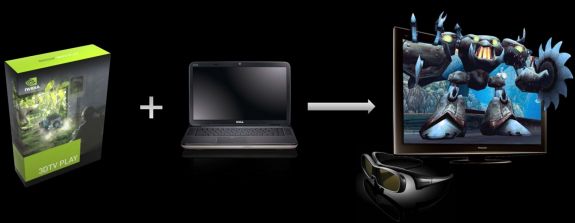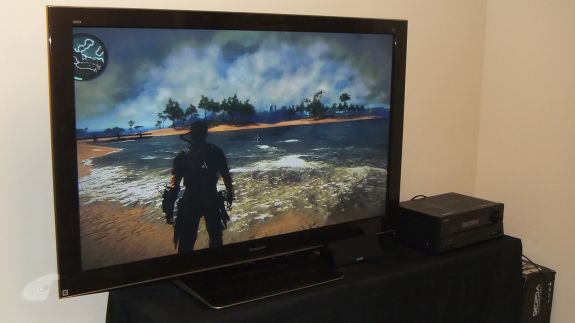NVIDIA Launches 3DTV Play, Bringing 3D Vision to the Big Screen
by Ganesh T S on October 21, 2010 9:01 AM ESTEarlier this year, NVIDIA quietly announced 3DTV Play, a driver add-on for 3D TV owners that would allow them to take full advantage of the HDMI 1.4a port on their 4xx GPUs / 3D Vision GPUs by enabling 3D over HDMI. Without 3DTV Play, the NVIDIA 3D PC experience had been restricted to NVIDIA 3D Vision capable monitors with specialized glasses, and for 3D TVs the experience was limited to just Blu-Ray 3D. Now after some months in limbo, 3DTV Play is finally being released and shifts this experience to the big screen.
Introduction
It is no secret that TV makers are heavily betting on 3D becoming popular to drive sales. However, the market reception has been lukewarm at best due to two reasons. First, 3D TVs are not the ideal home experience due to the necessity for glasses and the health warnings associated with 3D content viewing. Secondly, there is a lack of content from the perspective of both console games and Blu-Ray movies to shift consumers to 3D TVs. There are very few channels broadcast in 3D, and the cost associated with covering events and programs in 3D is much more than the standard 2D broadcast. Studios are unwilling to invest much further in this till the consumer demand for such channels increase. In this scenario, the PC platform emerges as the leading provider for 3D content. In addition to a large number of 3D game titles, we are also starting to get user generated 3D content such as those from the recently introduced Fujifilm 3D camera and Panasonic camcorders. With years of development for the 3D ecosystem behind them, NVIDIA has taken up the opportunity to bring it to the TV platform with 3DTV Play.
Technical Details
3D Vision has been around for quite some time, and it uses a dual link DVI connector to supply the 120Hz refresh rate necessary to sync with shutter glasses in order to provide a 3D effect. With the bandwidth available in dual link DVI connectors, it is possible to push across 120Hz signals at up to 1920x1200 for a smooth HD 3D experience. Unfortunately, 1080p60 (120Hz actual, 60Hz per eye) is not part of the HDMI 1.4a standard. Present day 3D TVs support upto 720p30 and 1080p24 for 3D signals. These are the type of video signals which 3DTV Play enables over the HDMI port of the 4xx GPUs. With 3DTV Play, consumers can experience 3D games and photos on their big screen TV.
From a developer perspective, the handling of the display of 3D games on a 3D TV is transparent. The game developer needs to develop only for 3D Vision and 3DTV Play handles the rest. And of course playback of 3D movies over HDMI onto a 3D TV already works and doesn't require this add-on.
Business Partners
Dell launched their new lineup of XPS laptops today. Featuring GF108 GPUs from NVIDIA, all of them have HDMI 1.4a ports. 3DTV Play comes bundled with the laptops. In addition to Dell, systems from ASRock (the Vision 3D, which we already reviewed) and some upcoming systems from Zotac also have this add-on bundled. Frankly GF108 systems aren't going to be the best examples of 3DTV Play, given the heavy overhead of stereoscopic rendering in games. The best platform for 3D gaming would be using GF104 (and ideally a pair of them), which at the moment may be a bit hard to swallow in an HTPC.
For consumers already in the NVIDIA 3D ecosystem (i.e. own a 3D Vision kit), 3DTV Play will be a free upgrade. Consumers without a 3D Vision kit but interested in using 3DTV Play with their TV's existing hardware will need to purchase it from NVIDIA for $39.99.
Charging for what is essentially a driver update might be a little hard to digest. However, the fact remains that people wanting to purchase 3DTV Play standalone are those who have invested in a 3D TV before the technology goes mainstream. $40 for a value add-on is probably not much for such consumers.
As we said in the GT 430 review, lots of companies are betting on consumers getting enamored by 3D for the upcoming holiday season. ATI will also be getting into the action soon with their 6xxx series GPUs. How important is 3D technology to you? Feel free to echo your thoughts in the comments. Your opinion will be one of the important factors which influence our coverage in this area.













28 Comments
View All Comments
zoxo - Thursday, October 21, 2010 - link
The problem is not glasses, but ACTIVE glasses. Some years ago CRT TVs graduated from being 50hz to 100hz, but now with these active glass nonsense we're back to 60hz.Consumer 3D should be like theater 3D. Passive, circularly polarized glasses. (Or glassless would be better still.)
erikstarcher - Thursday, October 21, 2010 - link
I have been gaming for a while now with polarized glasses on an IZ3D monitor. I don't understand why everyone says it doesn't add anything to the experience. That is like saying that surround sound doesn't add to anything. When I play video games, anything that adds to the immersion factor makes it a better experience.B3an - Friday, October 22, 2010 - link
Things only add to the gaming experience when they dont also take things away. Using surround sound or having HD or higher resolutions dont take anything away, they just add to the experience. 3D on the other hand takes away image quality, colour accuracy, brightness, and has flickering.nbjknk - Thursday, November 25, 2010 - link
Dear customers, thank you for your support of our company.Here, there's good news to tell you: The company recently
launched a number of new fashion items! ! Fashionable
and welcome everyone to come buy. If necessary, please
plut:==== http://www.vipshops.org ======
==== http://www.vipshops.org ======
==== http://www.vipshops.org ======
stottle - Thursday, October 21, 2010 - link
I thought one of the main reasons 3d hasn't worked before was because of the headaches you could get from watching at lower than 60Hz. I thought that was why we needed 120Hz TVs before the technology could take off. I guess I haven't been following close enough, but this is the first time I've heard that HDMI 1.4a only supports 24p, not 60p at 1080 resolution. Hasn't this been shown to cause problems? I know it was touched on in the article, but hasn't it been shown to cause problems?flamethrower - Thursday, October 21, 2010 - link
First page of article:"...and the health warnings associated with 3D content viewing"
There are health warnings associated with 3D content viewing? Are there actual health risks associated with this activity? There are health warnings associated with videogames but that doesn't seem to be hurting that industry.
ganeshts - Thursday, October 21, 2010 - link
Yes, there are health warnings and the effects are more easily visible / experienced compared to those associated with video games. Video game health effects are usually experienced after repeated usage, whereas headaches and nausea are experienced by many people after just 4 - 5 hours of viewing 3D content. The quality of the display and the shutter technology also plays an important role in this.In fact, the Samsung UN46C800 3D TV that I was setting up a few days back flashed the health warning message as soon as I switched on the 3D mode.
mac2j - Thursday, October 21, 2010 - link
Observation 1: The following sentence "3D is a fad" is popular with people over the age of 35. The rest of us, however, see it as a technology who's time has come and a market that will continue to expand as the technology matures.Observation 2: Home 3D TVs really need to be 120Hz if not 240Hz. Ideally native 120Hz similar to the way the 120Hz monitors work. The AMD 6800/6900 cards have Displayport 1.2 which would support up to 240Hz at 1080p - that would eliminate a lot of the visual compromises and any perceptable flicker. I don't know if the GTX580 has Displayport 1.2 support but hopefully HDMI 1.5 will support similar bandwidth levels.
Observation 3: Better glasses tech is coming but we're stuck with some kind of glasses for many years from now.... although someone may get creative with the design so you can look through a fixed shield without actually wearing glasses or who knows, maybe to allow multiple customized focal points to eliminate the need. Real holographic 3D is 5-10 years off .... its just too much data at every level from imaging to processing to transmitting.... so if you can't handle any kind of glasses then you should just forget about 3D for a while.
JarredWalton - Thursday, October 21, 2010 - link
I strongly disagree with item number one. 3D has been attempted many times over the years, and every time it *was* a fad. Sure, you could say that the red/blue glasses were weak sauce, and they were, but polarized glasses have been around for a while and 3D still didn't catch on. Hollywood is pushing 3D hard now, with help from the HDTV makers and NVIDIA, but I would venture a guess that it has a lot more to do with trying to make money (i.e. you need to upgrade your 3-year-old 1080p HDTV; movie theaters need to go digital, etc.) than it does with thinking the current 3D is truly revolutionary. IMO, the "revolution" will come when we get affordable holographic displays, and that's a long ways off as you point out. (I'd guess more like 10-15 years minimum for them to reach the home).RedemptionAD - Thursday, October 21, 2010 - link
The issue isnt that it hasn't been done before. It's that it hasnt been done right yet. Ditch the glasses make the screens affordable and I think it will be a winner. Look at current tech as raising funds for future tech to get it where it needs to be. HD has been out for close to a decade. Only in the last 3-4 years has it truly taken off. and regular broadcast tv was around for 50 years before HD became available.